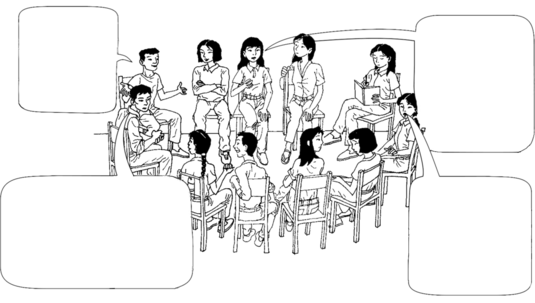Hesperian Health Guides
Gender is not biology
When a baby is born, people ask, "Is it a boy or a girl?" You can look at the baby’s genitals for the answer. The baby’s sex is female if she has a vulva, and the baby’s sex is male if he has a penis. These sex traits are part of biology. But gender is different. Our cultures, traditions, and laws assign male and female gender roles. They say women do housework, and men make important community decisions. People often confuse gender roles with sex roles and treat them as "natural" or unchangeable — "just the way things are."
To understand the connection between gender and health, we have to understand which parts of being male and which parts of being female are biological, and which are decided by people. Knowing the difference can help us decide what we can change and where we should focus our efforts to remedy the inequality of men and women in our communities.
Contents
Activity
Sex and gender roles: What is the difference?
- Put a picture of a man and a woman on 2 separate sheets of paper. Ask people to say everything they think of when they hear the word "man" and "woman," and write their ideas on each paper. Ask people to think of physical qualities, personality traits, abilities, roles in the family and community, and how men or women are supposed to feel and to act. Then read both lists out loud to the group.
 strong toughbreadwinnerpenis does not crydoes not ask for helpviolent big musclespolice father testicleshas sex when he wantsin control doctorathlete bravejudge beardleaderplays sportsquiet prettybreastsmonthly bleedingpregnant mothercaretaker emotionalfollows men's leadpleases others maidpractical obeys fathernurse teacher sexymakeup passivebears childrencooking cleaning
strong toughbreadwinnerpenis does not crydoes not ask for helpviolent big musclespolice father testicleshas sex when he wantsin control doctorathlete bravejudge beardleaderplays sportsquiet prettybreastsmonthly bleedingpregnant mothercaretaker emotionalfollows men's leadpleases others maidpractical obeys fathernurse teacher sexymakeup passivebears childrencooking cleaning - Switch the pictures, so the woman’s face is at the top of the list of ideas for "man" and the man’s face is at the top of the list of ideas for "woman." Ask the group which words in the "man" list absolutely cannot describe women, such as "father" or "testicles." Cross these words out. Explain that all the crossed-out words have to do with the male sex. The words that remain describe the gender roles that society expects men to follow.
- Do the same with the words in the "woman" list. Cross out the words that absolutely cannot describe a man, such as "monthly bleeding" and "bears children." The crossed-out words relate to women’s bodies, their sex. The words that remain describe gender roles.
- Discuss the difference between sex (physically being a man or a woman) and gender roles — the ways women and men are expected to look, feel, think, and act. Here are some possible questions:
- How would you describe the difference between sex and gender?
- Do you agree with all the ideas that describe women and all the ideas that describe men? Which do you disagree with? Why?
- Which gender roles are most often shared between men and women?
- How do boys and girls learn their gender roles?
- Ask the group what other things might affect gender roles, such as age, education, skin color, or whether a person owns property or belongs to a certain caste or clan.
How are gender expectations different for women and men with higher or lower status? Who has more power to make decisions for themselves and others? Who has more freedom to say what they think, and do what they decide is best? - Finally, discuss how differences in gender expectations affect women’s health and men’s health. Which roles and expectations make it easier for women or men to stay healthy? Which expectations may cause more health problems in women or in men?

Seeing masculinity and femininity
Gender roles create expectations about what is an ideal (masculine) man and what is an ideal (feminine) woman. When gender expectations in a community include mutual respect and appreciation for differences in roles and identities, men and women can experience life with satisfaction, belonging, and accomplishment. But feminine roles often have a much lower status than masculine roles. Unequal status between genders is especially harmful when being male means having control over women or any person who appears or feels more feminine.
One way to see differences in men’s and women’s status is to reflect on the qualities of femininity and masculinity that most people admire. This can help people think about which qualities are approved by the community, and why. This kind of reflection also helps a group understand how most women and men usually act to reinforce gender expectations, and what happens if a person acts differently.
Activity
Gender boxes
- Divide your group into smaller groups of women or men. Give each small group a large piece of paper.
- Ask each group to draw a picture of an "ideal" woman or an "ideal" man, either their own sex or the opposite one. They should dress the person in an ideal way. Ask them to then draw a big box around the picture so the whole person is inside the box.
- Next ask the groups to write or draw around the body inside the box all the qualities of an ideal woman or man. Ask people to think of the ways women and men are expected to look and act in the community, in the work they do, in the family, and in sexual relationships. What are men supposed to be good at? What are women supposed to be good at? What feelings are OK for men to show? For women to show?
- Then ask the groups to think of qualities that many women or men have that are not considered ideal. Write or draw these qualities on the paper outside the box. You can ask: What feelings should men hide? What about women?
 smallcries when sadweakshortno jobstrongrespectedafraidnot competitiveemotionalloves to cookhandsomeconfidentgood salarygood providerno moneydemandingadventurouslikes to play sportsknows too muchquiethelpfulcapableaggressiveassertivelouduglytoo fatloves schoolreads a lotprettyselfishstrong
smallcries when sadweakshortno jobstrongrespectedafraidnot competitiveemotionalloves to cookhandsomeconfidentgood salarygood providerno moneydemandingadventurouslikes to play sportsknows too muchquiethelpfulcapableaggressiveassertivelouduglytoo fatloves schoolreads a lotprettyselfishstrong - Bring the groups together and have them present their drawings.
- Discuss the drawings and the expectations they show. For example, ask how the ideal man or woman benefits from the qualities or actions inside the box. Which qualities or actions are considered weaker or less important? Why?
- Ask the group if they think it is difficult for most women or men to achieve these ideals? Why? What happens to people who do not fit inside the "ideal" box or to people who try to live outside the "ideal" boxes? Are there both benefits and disadvantages to being different? In what ways? (You might note that real people have a bit of both boxes.) Ask the group: How might the boxes affect men’s and women’s health?
- Then ask: Where do the boxes come from? When do people learn the "rules" about being girls, boys, women or men? Who teaches the rules? How much comes from parents? How much from other authorities like teachers, coaches, or religious leaders? How much from the media — TV, advertising, films, songs, and videos?
To continue exploring gender roles with a group of women only, you can do the activity, What if there were no gender boxes?
Imagine a world without gender boxes
Women often talk with each other privately about their experiences and feelings. Talking about the difficulties in their lives — especially about difficult relationships with men — helps women feel less alone. But this kind of talk usually does not question the causes of their difficulties or how things could be different. A reflection and sharing activity can provide a comfortable and safe place for women to discuss their experiences and compare their roles with men’s roles.
This activity can be done following the Gender boxes activity to help a group consider how gender roles and expectations could change in ways that enable women to have more control over their health.
Activity
What if there were no gender boxes?
Do this activity with a group of women and girls, without men or boys present. (You can adapt this for men and boys.) Show the group the gender boxes that were drawn using the activity above. Explain that this activity can help us to think about how things could be different — what if there were no gender boxes at all?
- Guided reflection. To make the setting feel more intimate and less like a meeting, ask the women to form a circle. You might want to make the room darker or play soft music. Ask the women to close their eyes, breathe deeply, and imagine themselves as little girls. Explain that you will be asking them to first remember and then to imagine things. The women will just think to themselves, not answer out loud — this is a silent exercise.
Speak calmly and slowly, and ask questions such as these:
- When did you first realize that being a girl was different from being a boy? How did you realize this, and how did you feel?
- How would being a girl have been different if boys and girls had been treated more alike? If they had the same freedoms and the same responsibilities?
- What would more freedom look like for a man? How would men’s lives be different if their roles and responsibilities were shared equally with women?
- What would more freedom look like for a woman? How would women’s lives be different if their roles and responsibilities were shared equally with men?
- Sharing in small groups. Ask the women to open their eyes and invite them to form small groups to share some of their thoughts from the guided reflection. Each woman should have enough time to talk while the other women listen quietly.
- Imagining a world without gender boxes. Once everyone has shared, ask the women to stay in their small groups and discuss the following questions:
- If girls and boys were treated more alike, how would girls act differently than they do now? How would they feel?
- If women had the same freedom, power, and responsibilities as men, how would women act? How would they feel?
- How would boys and men act and feel?
- How would your own life be different? How would life be different for other
- Drawings without boxes. You may also want to ask the groups to create new drawings to show what life would be like without gender boxes. Give each group a large piece of paper and ask them to draw the ideal woman in a world where women have the same freedom, power, expectations, and responsibilities as men. You can ask them to draw an ideal man too.
 Ideal womansmartdoes not give upkindstudies hardskilledmotherconfidenteducatedsolves problemsboldmakes decisionsstronggood cookgood jobIdeal manforcefulcaringtakes care of sick childrencapablepatientshares houseworkhas a skillloyalunderstandingdoesn't get drunkshares moneyworks hardbravehelpful
Ideal womansmartdoes not give upkindstudies hardskilledmotherconfidenteducatedsolves problemsboldmakes decisionsstronggood cookgood jobIdeal manforcefulcaringtakes care of sick childrencapablepatientshares houseworkhas a skillloyalunderstandingdoesn't get drunkshares moneyworks hardbravehelpful - To end, ask the groups to share their visions and drawings. You can ask everyone to say what would be different for the health of women and girls, and for the health of men and boys. Be sure to leave time for the participants to share how they felt while doing the activity and what they are thinking about now after the discussions and drawings.
Gender and work
In every community, some types of work are considered "men’s work" and other types of work are considered "women’s work." These differences in expectations about work are part of gender roles.
The work that many women do — caring for children and the daily needs of the family — is often not highly valued nor even thought of as work. This is one cause of women’s low status and unfair workloads. Discussing gender roles and work can help people think about changes in women’s lives that could improve women’s health.

Activity
A day in the life
Making lists of the activities that men and women do in a day can provide good material for discussing work and gender. Sometimes men or women may not have a very good idea of what the other gender does all day! You can also adapt this activity with a women-only group to raise awareness about their household responsibilities as work to be valued.
- Divide your group into smaller groups of either men or women. Ask the groups of men to make a list of all the activities a typical man completes in a normal day, starting from the time he wakes and ending when he goes to sleep. Ask the women to do the same thing for women. You might also ask people to think about how long each activity takes, where it happens, and who helps them with the activity.
- After the first list is complete, ask the men’s groups to make another list with all of the activities they can think of that women do in the same time period, and ask the women’s groups to make a list about men.
- When both lists are finished, share them in the big group.
- Discuss making the lists. You can ask if people are surprised by any part of the lists or any part of making the lists. Do they think the women did a good job of listing the men’s activities? Did the men do a good job of listing the women’s activities?
- Discuss what is on the lists. What is different about the kinds of activities women and men do? Why do women and men do different kinds of activities? Which activities on the lists of men’s work could women do just as well? Which activities on the lists of women’s work could men do just as well? Why could they or could they not?
- Discuss other differences between women and men that are related to each gender’s work. For example, ask which group has more leisure time to spend as they like. Which group has a larger workload? Do people think these differences are justified? Why or why not? You can also ask about women or men who do some of the work on the other gender’s list. Why do those people do work usually expected of the other gender? Are they more or less respected for doing that work?
- To end the activity, ask the group if they would like to change any expectations about men’s and women’s daily activities and workloads. Ask them to explain how such changes would benefit women and men. What challenges would there be? Discuss what each person can do to make those changes happen, what others can do, and how the group can help the whole community change.
 I never thought of what women do as work.Even though I work all day in town, I still have work at home and never get to rest.I always thought men needed more food and rest because they worked harder. Now I think women work hard but eat and rest less.It seems women work more hours and rest less. That doesn’t sound fair!
I never thought of what women do as work.Even though I work all day in town, I still have work at home and never get to rest.I always thought men needed more food and rest because they worked harder. Now I think women work hard but eat and rest less.It seems women work more hours and rest less. That doesn’t sound fair!
Red Thread unites women for health and rights in Guyana

People in Guyana, South America, belong to different ethnic groups with different customs and traditions. One group is mostly descended from Africans brought there as slaves, another from Indian immigrants, and a third group is mostly native to Guyana. For many years these different ethnic groups were deeply at odds, and the women did not feel they had much in common. An organization called Red Thread wanted to find a way to unite the women and work together to raise the status of all Guyanese women. Red Thread created a survey to learn how women spend their time. Red Thread members visited women all over the country and used the survey to ask them what they did all day. They discovered that most women’s days were similar: they rose early, collected water or fuel, cooked, fed their families, cleaned, tended a small garden, had a paid job, washed clothes, looked after children, and did various other things. Almost all the women worked 15 to 16 hours each day. Red Thread showed the results of the survey to the women and asked, "Why are we dividing ourselves? We are all doing the same work." This project was a great unifier. Red Thread grew into a strong, multi-ethnic women’s group, working in many ways to promote women’s rights, including earning money and ending gender-based violence.
Gender roles change over time
Gender roles often assign a lower status to women, which means less access to health care, less control over your own body, more hours of work, and less decision-making power. For communities to improve women’s health, they need to change gender roles, especially those that make women vulnerable to men. This might seem very hard to do, but less hard when we see that gender is not biological — that what we think of as masculine or feminine comes from our ideas about men and women, not from nature. It also helps to remember that gender roles have changed over time in every part of the world. Discussing women’s lives in the past compared to the present can help people see that gender roles do change and how these changes might improve women’s health.
Activity
The way we were
In this "fishbowl" activity, older women sit in an inner circle and talk about what their mothers’ lives were like. The younger women sit in the outer circle and listen, and then ask questions later. After their questions are answered, the groups switch places so that the younger women can share some of their thoughts about how things seem to have changed, while the older people listen.
- To prepare the older women, ask them to speak about the things they learned from their mothers about femininity and being a woman. Also, how are their lives different from their mothers’ lives? What changed to make their lives as women different? Why did the changes happen? Ask if there were ways in which they, their friends, or their mothers rebelled against the community’s expectations for women? How have some women broken with traditional gender roles? What happened to them? You might also ask them to tell the younger women about changes in customs and rules for friendships and romances between boys and girls. How have rules changed for courtship, sexual relationships, and getting married? What did women do in the past to care for their health?
- When the young women have their turn in the fishbowl, ask them to begin by telling the group what they like about being a woman and what they think is unfair about being a woman. How do they think their ideas about being a woman are different from their grandmothers’ ideas? The ideas of others in their community? Ask them to talk about their goals for the future. Who are some women they admire? Why? What do they hope for in a romantic partner or husband? What do they picture as a healthy life for themselves in the future?
- To end, ask the whole group what this activity shows us about gender and how it changes over time, and how we can help change it in our lifetime.



